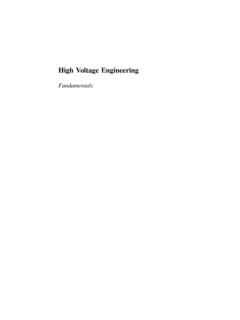Transcription of Insulation Resistance Testing - Southwire
1 Application Note Insulation Resistance Testing Megger Testing Purpose: Insulation Resistance Testing is a non-destructive test procedure. The test measures the insu- lation Resistance between the phases and/or between phase and ground. It is commonly used in the industry for acceptance Testing prior to energizing the cable and for maintenance Testing programs. General Testing Information For single conductor non-shielded cable on a reel, Insulation Resistance Testing cannot be performed due to the fact that low voltage single conductors do not have a grounding con- ductor, shield or ground plane. For other cable on a reel, Insulation Resistance Testing can be performed provided the seal- ing caps are removed. The procedure to test these cables is outlined below.
2 NOTE: It is important to remove sealing caps from both ends of the cable to be tested. Resi- due inside the sealing cap can be conductive and lead to false readings. Equipment: DC Insulation Tester (Megger). Safety: Before conducting tests on cables, verify circuits are de-energized. Follow all safety practic- es according to NFPA 70E and NESC C2-2012. Follow Insulation tester instructions and guidelines. Only qualified persons should perform this Testing . Preparation: Ensure that test equipment is in good working order and has been calibrated within the last year. Clean up the area. Good housekeeping and environmental conditions are important since Insulation Resistance readings are affected by dirt, moisture and heat.
3 Disconnect cables from equipment on both ends. Clean cable ends/lugs with appropriate cleaning solution. If lugs or accessories are not being used, cutback the cable as described below. 01/23/2017. 2202 Insulation Resistance Testing On the end not being connected to the test equipment, make sure sufficient clearance (six inches or more). is maintained between cable ends and the ground plane. For 600 5,000 Volt Non-Shielded Cable Measure from cable end. Make a 360 ring cut on Insulation without cutting into . the conductor. Make a longitude cut on Insulation from the ring cut to cable end. Remove the cables Insulation from the end of the cable. Clean the cable end to remove dirt and contaminates that may be present. For 2,400 - 35,000 Volt Shielded Cable Mark the cable jacket 8" from cable end.
4 At this location, make a 360 ring cut on ca- 8 . ble jacket. Next make a longitude cut on the 1 1 6 . jacket from ring cut to cable end. Remove . this section of the jacket, taking care not to nick tape shield below. Measure 1 from the cable jacket toward cable end and apply a constant force spring at that mark, remove the tape shield by using the spring as a guide. Tear the tape off against the constant force spring. Measure 2 from cable jacket to the semicon and apply a constant force spring at that mark. Make a 360 ring cut at this location. Now make two to three longitude cuts from the ring cut to cable end, taking care not nick Insulation below. Remove the semi-con. Measure and mark the Insulation from cable end. Apply a constant force spring at the mark.
5 Make a 360 . ring cut at the mark, then make a longitude cut from the ring cut to cable end. Be careful not nick conductor below. Remove the Insulation . Test Procedure: At the test end, ground the conductors in the circuit except for the conductor being tested. This will en- sure that the tester is only measuring leakage current in the selected conductor. Connect the appropriate tester leads to the conductor to be tested and to the adjacent conductor, shield, or ground plane (or metallic conduit). Use the guard circuit if available on the Insulation Resistance test set. The guard circuit will remove any surface leakage on the conductors and improve the accuracy of the test readings. The guard circuit should be connected as shown in the illustration above.
6 See your testers instruction manual for details. Make sure both cable ends under test are suspended in free air. Having the cable end near conductive Southwire Company, LLC | One Southwire Drive, Carrollton, GA 30119 | page 2. Insulation Resistance Testing Shielded Cable Non-Shielded 537 M . TEST. + G - path can affect the test and reduce the Insulation Resistance reading. Suspend and isolate the test set leads in air as much as possible. Do not allow the leads to touch during the test. Do not touch or move conductor during Testing as results will be affected. Perform the test and record the Resistance readings on the attached form. Be sure to record results for at least 10 minutes. Depending on the type of cable, a different number of tests will be required to test all the conductors.
7 Use Table 1 to determine which conductors need to be tested and what the ground reference should be. After a conductor is tested, ground the conductor for a period of at least 4 times the duration of the test (For a 10 minute test the conductor should be grounded for 40 minutes). This will safely remove any capacitive charge left on the conductor. Table 1. Southwire Company, LLC | One Southwire Drive, Carrollton, GA 30119 | page 3. Insulation Resistance Testing Cable Type Test to Perform Notes Medium voltage Shielded to Shield Conductor shield Medium voltage Non-Shielded to . to Ground Earth ground or the cable's metallic conduit Low voltage Multi-Conductor to . to Ground Earth ground or the cable's metallic conduit to Neutral Neutral to Ground Example You have a single conductor 500 kcmil, 15kV cable.
8 You perform this Insulation Resistance test on the cable and record the data on a copy of the attached form: For a good cable, you will see results similar to those on the following page. The Resistance values will increase over time due to capacitive and Insulation charging. As the charging becomes more complete the re- sistance readings will level out. How long that will take will depend upon the cable size, capacitance, length, and other factors. A 10 minute test should be long enough to get good test results on most cables. The highest Resistance reading should be at the 10 minute mark. You will need to normalize that value for a standard cable length. To do this you will need to use the equation at the bottom of the form.
9 In this case we have: R equal to G . L equal to 4020 ft. This gives us: R 1000ft = R x L/1000 = x 4020/1000 = G 1000ft. = 67,500 M 1000ft. Comparing this result with the correct row of Table 2 shows that our cable passes the Insulation Resistance test. If the Cable Does Not Pass If a cable does not pass the test the cable still may be good but additional cable evaluation should be per- formed. The first thing to check is the cable Testing environment and cable preparation. Dirty cables and high humidity can have a significant negative impact on the test results. Are both cable ends prepped correctly and isolated from any possible conductive path? Is the cable damp? Try cleaning the cable ends with cable cleaning wipes and test again.
10 Is the cable isolated from other components? The problem may not be with the cable but could be with the cable connectors, terminations or transformers or other equipment the cable is connected to. While disconnecting the cable from the circuit can be a tedious task, it can make a big differ- ence in the test results. If after trying all the above still does not yield valid test results contact your Southwire representative for additional information. Southwire Company, LLC | One Southwire Drive, Carrollton, GA 30119 | page 4. Insulation Resistance Testing Date: 12/19/16 Circuit: Reel #1. Temperature: 70 F Cable Size 500 kcmil Humidity: 52% Rated voltage : 15kV. Cable Length (L): 4,020 ft. Test voltage : 2500V. Tester Name: Manufacturer: Southwire e x Resistance (R) in: M G.





